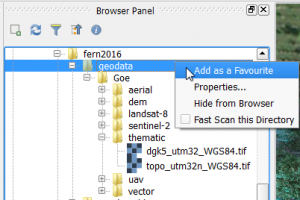Georeferencing of UAV photos
Contents |
Preparation
- Open Qgis with a new project.
- Install the Openlayers plugin (if not yet done) Plugins --> Manage and Install Plugins --> Install.
- Activate the Georeferencer GDAL plugin (if not yet activated): Plugins --> Manage and Install Plugins --> Installl. Check the box beside the Georeferencer GDAL plugin.
- Prepare main Qgis map viewer
- Right click on the upper part of the main Qgis menu. In the Panel check the box beside the Bowser panel. Drag the Bowser panel window on top of the Layer panel. Browse to your geodata folder where the tutorial data were stored and extracted. Mark geodata and right click Add as a favourite.
 .
.
In Bowser panel double click on geodata\Goe\thematic\topo_utm32_WGS84.tif to load a topographic map 1:25.000.
- Load Google maps as background layer. Web --> OpenLayers Plugin --> Google Maps --> Google Satellite. The Project Coordinate system switches automatically to EPSG:3857, WGS 84 / Pseudo Mercator where Enable 'on the fly' CRS transformation is checked. In the Layer panel drag topo_utm32_WGS84 on top of Google Satellite. Double click on topo_utm32_WGS84 to open Layer Properties --> Transparency and change Global transparency to about 70% by moving the slider. Apply.
- Load a raw UAV photo. In Bowser panel double click on geodata\Goe\thematic\DJI00857.JPG. The Coordinate Reference System Selector opens. The UAV photo is a raw image file in JPEG fornmat which does not contain information on a spatial reference system. Just press ESC to load the image. Project Project --> Properties and check Enable 'on the fly' CRS transformation off. Mark DJI00857 in the Layer panel and right click Zoom to Layer. In Layer panel double click on DJI00857 to change the band assignement in Layer properties --> Style to Red band = Band1, Green Band = Band2 and Blue Band = Band3. The raw UAV image is now shown as a true color composite. Striking are the distortions caused by the ultra-wide (fisheye) lens of the UAV camera. [[File:browser_panel.png]
- Load geodata\Goe\thematic\DJI00857_entzerrt.tif in the map viewer where lens distortions were removed using calibration coefficients of a camera model. Open DJI00857_entzerrt.tif in a general image viewer (e.g. MS Windows photo viewer) and rotate the image such that it is correctly oriented to the north direction which facilitates the selection of ground control points. Open Project --> Project Properties , choose EPSG:3857, WGS 84 / Pseudo Mercator and check Enable 'on the fly' CRS transformation on. Mark topo_utm32_WGS84 in the Layer panel, right click Zoom to Layer.
Registration of ground control points (GCP)
Open the Georeferencer window: Template:Raster – Georeferencer – Georeferencer In the georeferencing window Template:File - Open raster Browse to your geodata folder. Template:Geodata\Goe\thematic\DJI00857 entzerrt.tif ((open)) Defining reference system with ESC (none) Change the band assignment to RGB = 1,2,3 with Settings - Raster Properties - Style. OK. Georeferencer Settings Configure Georeferencer check the box beside 'Show IDS'.
Template:Georeferencer - add point Template:Georeferencer - add point See sceenshot ´´Add_Point.jpg´´ A cross shows up. Move the cursor to the first ground control point (e.g. a drain cover). Zoom in and mark the GCP with the croos and register position in the image shown in the Georeferencer. Enter map coordinates : From map canvas. OK. Zoom in to the same point in Google maps. In the Layer panel switch topo_utm32_WGS84 on and off. Attention! if the zoom factor is too large the Google maps is not displayed or not on the correct position. The coordinates of the main viewer are transferred directly to the Enter map cordinates window. OK. Zoom to the next control point, activate add point and continue until you have registered 10 GCPs.
For changing the position of a point that is already defined: ((move GCP point)) (second button on the right of the ´´add point´´ button) Move the point by clicking on it.
Transformation and Resampling
Raster Projections Warp (Reproject)